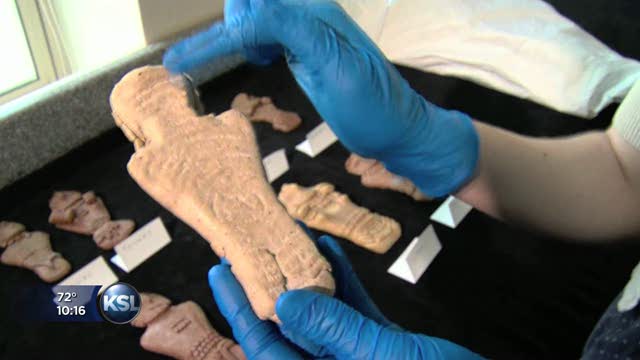Estimated read time: 3-4 minutes
This archived news story is available only for your personal, non-commercial use. Information in the story may be outdated or superseded by additional information. Reading or replaying the story in its archived form does not constitute a republication of the story.
LOGAN — One of the nation’s national treasures is back where it belongs.
“I am gonna say it, that we have found the lost Pilling figurine," said Dr. Bonnie Pitblado, director of the Utah State University Museum of Anthropology.
Last year, Pitblado received the object wrapped in a leather cover and a note that read in part: “Sometime between 1978 and 1982 I came into possession of this piece by way of a vagabond acquaintance. He had told of ‘acquiring’ it near Vernal, Utah. I have great interest and respect for this continent's native culture and have always hoped to somehow return this to wherever it had come from. … I am very excited at the prospect of it being returned to its proper place.”
Researchers weren’t initially sure it was the missing figurine. “When we first saw it, everybody had the same response, ‘Oh, could it be? It sure looks like it,'” Pitblado said.
The figurine is believed to be one of 11 remaining figurines discovered in March 1950 by Clarence Pilling in a small side canyon of Range Creek. The figurines, known worldwide as the Pilling figurines, are between 4 and 6 inches in height. They are made of unbaked clay and are decorated with applied clay ornaments. Each figurine is distinctive and shows evidence of red, buff and black paint.
They were all placed together in this particular setting, underneath an example of Fremont rock art with a few other objects as well, and left that way for a thousand years.
–- Bonnie Pitblado, USU
“They’re paired male, female figurines,” Pitblado said. It isn’t known if they actually represent real couples. “They were all placed together in this particular setting, underneath an example of Fremont rock art with a few other objects as well, and left that way for a thousand years,” she said.
One of the figurines disappeared while on tour in the 1960s.
Because occasionally people will try to fake the archaeologist, they wanted to make sure it was the real thing so they ran several tests. The figurines have fingerprints on them, so “we collaborated with the crime lab in Salt Lake City to see if we could possibly get a match,” she explained
They also conducted some chemical tests to prove that the clay was the same and that it contained the same protective coating that was placed on the collection during the 1950s at the Harvard Peabody Museum. The back of the figurines also have a very distinctive basketry pattern.
“The energy in the room was tangible when we told our colleagues at the museum over in Price,” Pitblado said. “I know for a fact, I was told that tears came to eyes, folks who were around when it went missing.”
Not having this figurine is like going to see the Mona Lisa and maybe not having the smile or having something across her face, she said.
It’s believed the figurines were made about 1,000 years ago. The Fremont culture is a pre-Columbian culture that inhabited sites in what is now Utah, and parts of Nevada, Idaho, and Colorado between 700 and 1300 A.D.
“Rarely, rarely do you ever have that happy ending,” Pitblado said. “So I am grateful for the person out there who had this and saw that it made its way back to the rest of the collection.”
The figurines were entrusted to Harvard’s Peabody Museum when they were found in 1950. Ten years later, the Pilling figurines went on display at the Utah State University prehistoric museum. The figurines also went on tour across the state and that’s when one figurine disappeared.
The figurine will appear with the rest of the collection at the Price Prehistoric Museum in May.
Pitblado will hold a free lecture titled [“Once Was Lost, But Now Am Found?!”](http://www.ceu.edu/htm/news/articleID=17019 ""Once was Lost, but Now am Found" lecture") on May 5 at 1 p.m. at the Jennifer Leavitt Student Center, 490 N. 300 East in Price.
“To have the collection back together the way that it was originally placed by Fremont folks a thousand or so years ago,” she said, “that’s the most important thing.”
Contributing: Mike Anderson
Email:vvo-duc@ksl.com









